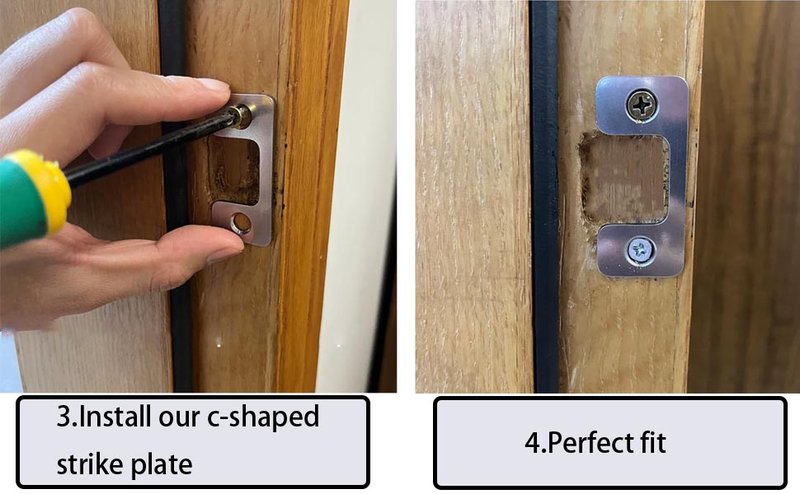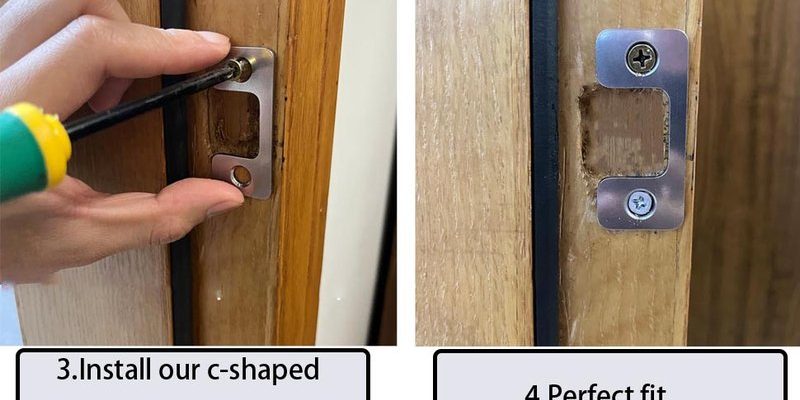
In simple terms, a strike plate is a metal plate installed on the door frame, into which the latch or bolt of the door fits when it’s closed. This essential hardware helps keep your door secure and protects against forced entry. Adjustable strike plates have a bit of flexibility built in, allowing you to reposition the latch hole. Non-adjustable versions are more fixed in their design. So, if you’ve ever wrestled with a door that doesn’t latch properly, understanding these two types of strike plates might just save the day.
What Is an Adjustable Strike Plate?
Adjustable strike plates offer a versatile solution for door security. They come with multiple cutouts, enabling you to shift the position of the latch hole. This feature means you can easily align the door latch with the plate, accommodating any minor irregularities in your door frame. It’s like having a friend who’s always ready to help you adjust your plans last minute.
The installation process for an adjustable strike plate is usually straightforward. You’ll typically start by removing the old strike plate, then align the new one so that the latch fits snugly into the correct hole. If the door doesn’t quite latch right after installation, you can simply adjust the plate instead of making extensive modifications to your door or frame.
In terms of durability, adjustable plates are often made from heavy-duty materials. This means they can withstand more pressure and are less likely to bend or break under stress. So, if you’re looking for a long-term solution, adjustable strike plates might be your best bet.
What Is a Non-Adjustable Strike Plate?
Non-adjustable strike plates, on the other hand, are more rigid. They come with a fixed hole size and position, which means that once you install them, there’s no room for adjustments. It’s a straightforward option, but it can lead to issues if your door is misaligned or if it shifts over time—like a friend who sticks to the original plan, even when circumstances change.
Installing a non-adjustable strike plate is typically a quick process. You would remove the existing one, position the new plate over the latch hole, and secure it with screws. This simplicity can appeal to those looking for a no-fuss solution, but do keep in mind that if your door fits poorly now, it might fit poorly later, too.
In terms of materials, these strike plates can vary widely. Some are made from thinner metal, which might not hold up as well under stress. If you’re in a high-traffic area or have children and pets running around, a non-adjustable plate might give you less peace of mind than its adjustable counterpart.
Pros and Cons of Adjustable Strike Plates
Let’s break down the advantages and disadvantages of adjustable strike plates.
Pros:
- Flexibility: With adjustable plates, you can shift the latch hole to better align with your door latch, making installations easier.
- Durability: Often made from stronger materials to withstand wear and tear.
- Problem Solver: Can resolve alignment issues without extensive modifications to your door or frame.
Cons:
- Cost: Typically, they can be a bit more expensive than non-adjustable options.
- Installation Complexity: Some may find the installation process slightly more detailed because of the adjustments.
If you’re someone who values flexibility and long-lasting durability, adjustable strike plates might just be the answer.
Pros and Cons of Non-Adjustable Strike Plates
Now, let’s look at non-adjustable strike plates.
Pros:
- Simplicity: With a straightforward design, installation is quick and easy.
- Cost-Effective: Generally, they are less expensive than adjustable plates.
Cons:
- Lack of Flexibility: If your door frame shifts or becomes misaligned, a non-adjustable plate can lead to issues.
- Potential Durability Issues: May not withstand heavy use or pressure as well as adjustable options.
If you’re looking for a simple, cost-effective solution and your door fits well, a non-adjustable strike plate could work just fine.
When to Choose an Adjustable Strike Plate
There are certainly times when an adjustable strike plate is the smarter choice. If you’re dealing with a new door installation or an old door that has seen better days, adjusting the latch position can be a lifesaver.
You might want to consider this option if:
– Your door has been misaligned after years of use.
– You have multiple people using the door, which could cause wear over time.
– You want a solution that adapts to changes, whether from settling or shifting frames.
Think of it as a safety net—you have the ability to tweak things as needed, ensuring your door remains secure.
When to Choose a Non-Adjustable Strike Plate
Non-adjustable strike plates can also be the right fit under certain conditions. If you’re installing them on a brand-new door with perfectly aligned hinges and frames, a non-adjustable plate might suffice.
Consider this option if:
– You’re on a tight budget.
– You’re dealing with a door that’s already in ideal condition.
– You want a quick, no-fuss solution that requires minimal modifications.
While less versatile, these plates can still offer security if installed correctly and aligned well.
Choosing between adjustable and non-adjustable strike plates comes down to your specific needs. Honestly, if you find yourself wrestling with uneven doors or looking for something that can adapt over time, an adjustable strike plate could be the right way to go. On the other hand, if you need an easy fix and your door is already set up well, a non-adjustable plate can do the job.
At the end of the day, both types serve their purpose well, but understanding how each one works—along with their strengths and weaknesses—will help you make the best choice for your home. Keep your doors secure and your worries at bay; after all, a little piece of metal can go a long way in keeping your home safe!
